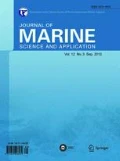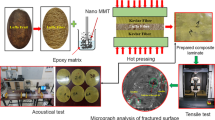Abstract
The use of a glass-fiber reinforced composite in marine structures is becoming more common, particularly due to the potential weight savings. The mechanical response of the joint between a glass-fiber reinforced polymer (GRP) superstructure and a steel hull formed is examined and subsequently modified to improve performance through a combined program of modeling and testing. A finite-element model is developed to predict the response of the joint. The model takes into account the contact at the interface between different materials, progressive damage, large deformation theory, and a non-linear stress-strain relationship. To predict the progressive failure, the analysis combines Hashin failure criteria and maximum stress failure criteria. The results show stress response has a great influence on the strength and bearing of the joint. The Balsawood-steel interface is proved to be critical to the mechanical behavior of the joint. Good agreement between experimental results and numerical predictions is observed.
Similar content being viewed by others
References
Adams RD (1989). Strength predictions for lap joints, especially with composite adherends—A review. Journal of Adhesion, 30(1–4), 219–242. DOI: 10.1080/00218468908048207
Adams RD, Atkins RW, Harris JA, Kinloch AJ (1986). Stress analysis and failure properties of carbon fibre reinforced plastic/steel double lap joints. Journal of Adhesion, 20(1), 29–53. DOI: 10.1080/00218468608073238
Anyfantis K (2009). Adhesive bonding of dissimilar materials: Literature review. Shipbuilding Technology Laboratory, National Technical University of Athens, Athens, Greece, Technical report No. STL-279-F-09.
Boyd SW (2006). Strength and durability of steel to composite joints for marine application. PhD thesis, School of Engineering Sciences, University of Southampton, Southampton, UK, 46–80.
Campilho RDSG (2009). Repair of composite and wood structures. PhD thesis, Engineering Faculty, Porto University, Porto, Portugal, 24–58.
Campilho RDSG, Banea MD, Pinto AMG, da Silva LFM, de Lesus AMP (2011). Strength prediction of single- and double-lap joints by standard and extended finite element modelling. International Journal of Adhesion and Adhesives, 31(5), 363–372. DOI: 10.1016/j.ijadhadh.2010.09.008
Cao J, Grenesdt JL (2003). Test of a redesigned glass-fiber reinforced vinylester to steel joint for use between a naval GRP superstructure and a steel hull. Composite Structures, 60(4), 439–445. DOI: 10.1016/S0263-8223(03)00020-5
Cao J, Grenesdt, JL (2004). Design and testing of joints for composite sandwich/steel hybrid ship hulls. Composites, Part A: Applied Science and Manufacturing, 35(9), 1091–1105. DOI: 10.1016/j.compositesa.2004.02.010
Clifford SM, Manger CIC, Clyne TW (2002). Characterisation of a glass-fiber reinforced vinylester to steel joint for use between a naval GRP superstructure and a steel hull. Composite Structures, 57(1–4), 59–66. DOI: 10.1016/S0263-8223(02)00063-6
Hart-Smith LJ (1986). Design of adhesively bonded joints. In: Matthews FL, (ed.). Joining Fibre Reinforced Plastics. Elsevier Applied Science, London, 271–311.
Hart-Smith LJ (2002). Adhesive bonding of composite structures—Progress to date and some remaining challenges. Journal of Composite Technology Research, 24(3), 133–153. DOI: 10.1520/CTR10566J
Hayman B, Echtermeyer AT, McGeorge D (2001). Use of composites in naval ships. Warship 2001-Future Surface Warships, London, 12–18.
Hentinen M, Hildebrand M, Visuri M (1997). Adhesively bonded joints between FRP sandwich and metal. VTT, Espoo, Finland, 8–36.
Hildebrand M, Hentinen M (1998). Efficient solutions for joints between large FRP-sandwich and metal structures. Proceedings of the 19th SAMPE Europe International Conference, Paris, France, 417–428.
Kapadia A (2002). Weight and cost comparison of base design structure to a given steel structure. Materials Research Department, Roskilde, Denmark, Technical Report No.VT-2.3-C3-IP3.0.
Kim SJ, Hwang JS, Kim JH (1998). Progressive failure analysis of pin-loaded laminated composites using penalty finite element method. AIAA Journal, 36(1), 75–80. DOI: 10.2514/2.354
Konstantions N (2012). Analysis and design of composite to metal adhesively bonded joints. PhD thesis, National Technical University of Athens, Athens, Greece, 1–208.
Lessard LB, Shokrieh MM (1995). Two-dimensional modeling of composite pinned-joint failure. Journal of Composite Material, 29(5), 671–697. DOI: 10.1177/002199839502900507.
Mouritz AP, Gellert E, Burchill P, Challis K (2001). Review of advanced composite structures for naval ships and submarines. Composite Structures, 53(1), 21–41. DOI: 10.1016/S0263-8223(00)00175-6
Smith CS (1990). Design of marine structures in composite materials. Elsevier Applied Science, New York, USA, 32–46.
Smith CS (1991). Response of hybrid GRP/steel superstructures to blast loading—theory and experiment. Proceedings of International Conference on Advances in Marine Structures, Dunfermline, Scotland, 392–415.
Theotokoglou EE, Moan TJ (1996). Experimental and numerical study of composite tee-joints. Journal of Composite Material, 30(2), 190–209. DOI: 10.1177/002199839603000203
Toftegaard H, Lystrup A (2005). Design and test of lightweight sandwich T-joint for naval ships. Composites, Part A: Applied Science and Manufacturing, 36(8), 1055–1065. DOI: 10.1016/j.compositesa.2004.10.031
Vandellos T, Huchette C, Carrère N (2013). Proposition of a framework for the development of a cohesive zone model adapted to Carbon-Fiber reinforced plastic laminated composites. Composite Structures, 105, 199–206. DOI: 10.1016/j.compstruct.2013.05.018
Wright PNH, Wu Y, Gibson AG (2000). Fibre reinforced composite-steel connections for transverse ship bulkheads. Plastics, Rubber and Composites, 29(10), 549–557. DOI: http://dx.doi.org/10.1179/146580100101540761
Author information
Authors and Affiliations
Corresponding author
Additional information
Foundation item: Supported by the National Natural Science Foundation of China (Grant No 61004008), the Central Universities under Grant HEUCFR1001 and LBH-10138 Higher Sliding Mode Control for Underactuated Surface Ship.
Rights and permissions
About this article
Cite this article
Li, X., Li, P., Lin, Z. et al. Mechanical behavior of a glass-fiber reinforced composite to steel joint for ships. J. Marine. Sci. Appl. 14, 39–45 (2015). https://doi.org/10.1007/s11804-015-1296-8
Received:
Accepted:
Published:
Issue Date:
DOI: https://doi.org/10.1007/s11804-015-1296-8




